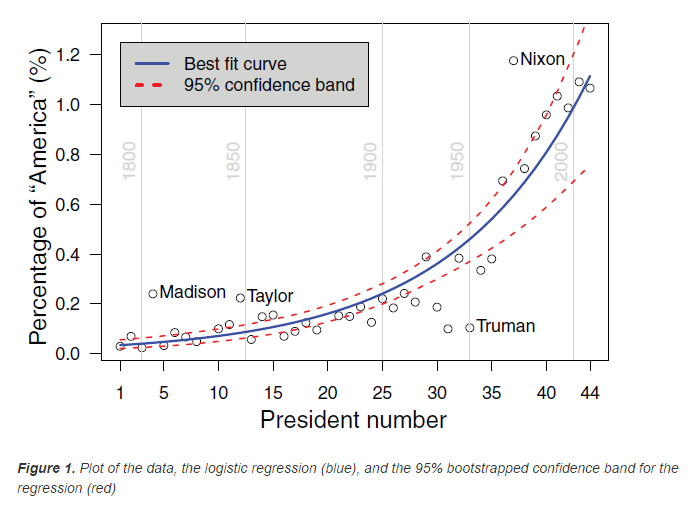Significance
« previous post | next post »
"Slow-talking the inaugural" was just reposted in Significance, a a statistics magazine published by the American Statistical Association and the Royal Statistical Society. Or following their logo,
which I guess can be approximated via Unicode as SIGNIFICΛNC≡.
I used to think that R.A. Fisher was the PR genius who appropriated the terms "significance" and "significant" to mean "(the property of being) less probable than one chance in 20 to occur by random sampling from a single distribution". And indeed the Wikipedia article on Statistical Significance says that
In 1925, Ronald Fisher advanced the idea of statistical hypothesis testing, which he called "tests of significance", in his publication Statistical Methods for Research Workers.
But the OED's earliest citations are
1885 Jrnl. Statist. Soc. (Jubilee Vol.) 187 In order to determine whether the observed difference between the mean stature of 2,315 criminals and the mean stature of 8,585 British adult males belonging to the general population is significant [etc.].
1888 J. Venn Logic of Chance (ed. 3) xix. 486 As before, common sense would feel little doubt that such a difference was significant, but it could give no numerical estimate of the significance.
[The first of those quotations comes from F. Y. Edgeworth, "Methods of statistics", Journal of the Statistical Society of London (1885): 181-217.]
I think that a deeper historical investigation would show that the earliest examples were basically uses of the ordinary language words in the context of quantitative evaluation of hypotheses, and that Fisher's contribution, 40 years later, was to codify or systematize what was already a common way of talking and writing. For more of the history, and some discussion of the basic issues, see "'Significance', in 1885 and today", 5/17/2013.
But however it happened, this terminological move was pure advertising gold. And like other lexical re-appropriations, it led to abuse, by enabling thoughtless people to think that "(statistically) significant" actually means "Sufficiently great or important to be worthy of attention; noteworthy; consequential, influential", or even just plain "true". See Chris Woolston, "Psychology journal bans P values", Nature 2/26/2015; Andrew Gelman, "Psych journal bans significance tests; stat blogger inundated with emails", 2/26/2015; or any of the many discussions of "statistical" vs. "practical" or "clinical" significance.
I should add that SIGNIFICΛNC≡, which I had not read on line before, features many articles more interesting than mine. For example, Adam Kashlak, "The frequency of 'America' in America", 10/26/2016, which features this plot:


D.O. said,
January 24, 2017 @ 2:24 pm
They should have called their publication "Bias and variance". That would be a good in-crowd joke. Even the better joke would be "Bias and deviation", but these words, common to statisticians' parlance, rarely come together.
Q. Pheevr said,
January 24, 2017 @ 4:39 pm
Or perhaps SIGNIFICΛNCΞ (with a Lambda instead of an A)? (I’ve also used Xi rather than ‘identical to’ for the final character—not sure exactly what they’re going for with the left-aligned shorter middle stroke.)
MikeA said,
January 24, 2017 @ 5:27 pm
If we are dabbling in Unicode, shouldn't the 'A' be a Lambda?
[(myl) Gee, I didn't even notice. Done.]
Rubrick said,
January 24, 2017 @ 6:19 pm
In parallel we also have "significant digit", which I assume without checking long predated the usage in experimental statistics. The mathematical usage doesn't seem especially ripe for abuse, though.
Edwin Schmitt said,
January 25, 2017 @ 2:59 am
The other problem I have seen creep up is when writing an academic article/book one uses the word "significant" to describe a phenomenon as "Sufficiently great or important to be worthy of attention; noteworthy; consequential, influential" and a reviewer will require you to "prove" that it is worthy of attention by displaying your "p-scores". It has a tribal quality to it, as in how could you be a real academic if you say "significant" and don't display your "p-scores".
For those interested, some of the early critiques of statistical significance began in the 80s with the work of Silvio Funtowicz and Jerome R. Ravetz. In particular see Funtowicz, S. and Ravetz, J., 1990. Uncertainty and quality in science for policy. Dordrecht: Kluwer Academic Publishers.
Michael said,
January 25, 2017 @ 5:56 am
And then there is the problem of multiple asterisks, and comments about "more significant" and the like…
I was present when Prof. Louis Guttman (of Guttman scale fame) suggested that the only criterion for accepting papers for a conference should be the lack of significance tests, because "they must have done it wrong".
Rodger C said,
January 25, 2017 @ 7:41 am
Bias and Deviation, the latest album from the 95% Confidence Band.
Ellen K. said,
January 25, 2017 @ 11:30 am
not sure exactly what they’re going for with the left-aligned shorter middle stroke
To make it look more like an E. Which in many, though not all, fonts, has a shorter middle line.
Bean said,
January 25, 2017 @ 2:35 pm
I thought it was supposed to be a very uninformative histogram. With three bins. Drawn sideways.
Hester said,
January 25, 2017 @ 10:51 pm
in romaji: SIGNIFICLNCX